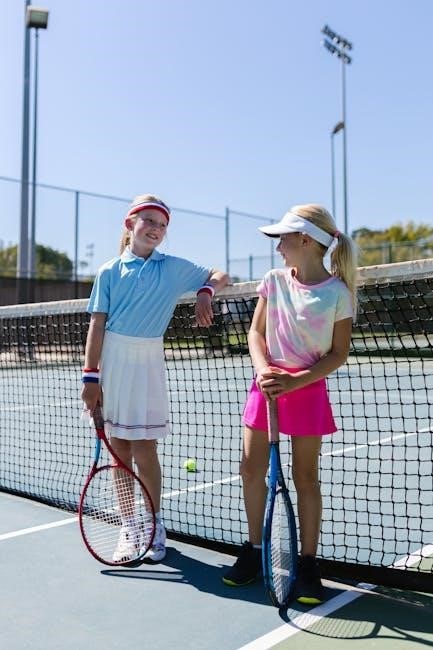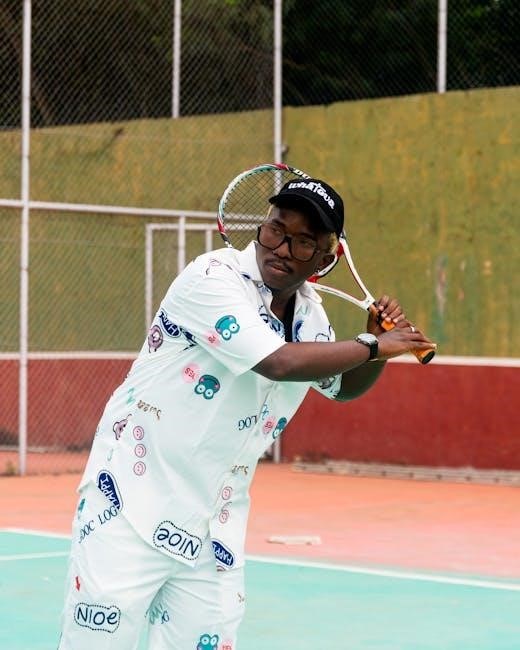Tennis drills are essential for building a strong foundation, improving consistency, and mastering techniques. They help beginners develop coordination, balance, and confidence on the court. Starting with basic exercises like groundstrokes and serves, players can progress to more advanced drills, ensuring a well-rounded skill set. Using low-compression balls and structured practice plans, beginners can enjoy a smooth transition into the game. Regular drills foster improvement, making tennis more enjoyable and rewarding over time.
1.1 Importance of Drills for Skill Development
Tennis drills are crucial for skill development as they help build a strong foundation and consistency in technique. By practicing specific shots and movements, beginners can master the fundamentals, such as forehands, backhands, and serves. Drills improve coordination, balance, and reaction time, enabling players to perform more effectively during matches. They also enhance vision and tracking skills, allowing better ball placement and control. Regular practice with drills ensures progressive skill improvement, making the game more enjoyable and rewarding. Using low-compression balls and structured drills, beginners can gradually adapt to the game’s demands, setting a solid base for advanced techniques.

1.2 Benefits of Practicing with a Partner

Practicing with a partner offers numerous benefits for beginners, enhancing learning and enjoyment. It provides real-time feedback and encouragement, helping to improve technique and build confidence. Partner drills, such as rallies and volleys, simulate match scenarios, preparing players for competitive situations. This collaborative practice fosters teamwork and communication, essential for doubles play. Additionally, playing with a partner increases intensity and motivation, pushing beginners to perform their best. Using structured drills from guides like the Tennis Drills for Beginners PDF, partners can focus on specific skills, ensuring a well-rounded development. Regular partner sessions accelerate progress, making tennis a more engaging and social experience.
Fundamental Drills for Beginners
Mastering groundstrokes, serves, and volleys is crucial for beginners. These drills focus on proper technique, consistency, and building confidence. Regular practice helps develop a strong foundation for progression.
2.1 Forehand Groundstroke Drills
Forehand groundstroke drills are fundamental for beginners to develop consistency and control. Start with partner rallies at the service line, focusing on proper grip, stance, and swing technique. Gradually increase distance to build power and accuracy. Wall drills are excellent for solo practice, allowing repetition and muscle memory development. Begin with short swings and progress to full strokes, emphasizing follow-through. Low-compression balls are ideal for slower rallies, helping beginners master timing and placement. These drills improve footwork, hand-eye coordination, and overall stroke production, laying a solid foundation for more advanced techniques.
2.2 Backhand Groundstroke Drills

Backhand groundstroke drills are crucial for developing a balanced game. Start with short swings, focusing on proper grip, footwork, and body rotation. Partner rallies from the service line help build timing and consistency. Use low-compression balls for slower-paced drills, allowing better control and accuracy. Wall drills are excellent for solo practice, enabling repetition and muscle memory. Progress to full strokes, emphasizing follow-through and recovery. Incorporate cross-court rallies to simulate match scenarios, improving footwork and shot placement. These drills enhance technique, consistency, and overall backhand performance, preparing beginners for more advanced play.
2.3 Basic Serve Drills
Mastering the serve is fundamental for any tennis player. Begin with the ball toss drill, focusing on consistency and height. Practice the serve motion without a ball to refine footwork and racket positioning. Use low-compression balls for slower, more controlled serves. Partner drills involve catching serves to improve accuracy and placement. Progress to full serves, emphasizing proper technique and follow-through. Incorporate target drills to develop precision and power. Start with underhand serves and gradually introduce topspin and slice. These drills build confidence and lay the foundation for a reliable serve, essential for competitive play.
2.4 Volley Drills for Beginners

Mastering the volley is a key skill for any tennis player. Start with stationary volley drills, focusing on proper racket positioning and footwork. Partner feeds the ball, and you practice hitting forehand and backhand volleys at the net. Use low-compression balls for better control and accuracy. Progress to moving volleys, where you approach the net and hit the ball while moving. Incorporate drills like “catch and throw” to improve hand-eye coordination. Practice volleys with both hands to develop all-around skills. Consistency is key, so aim to hit 10 consecutive volleys without missing. These drills build confidence and prepare you for real-game scenarios at the net.

Footwork and Agility Drills
Footwork and agility drills enhance speed and coordination, crucial for tennis. Cone drills, ladder exercises, and figure 8s improve movement efficiency, preparing players for dynamic court scenarios.

3.1 Cone Drills for Improved Movement
Cone drills are excellent for enhancing agility and speed. Players weave through cones using various footwork patterns like lateral slides, high knees, and carioca drills. These exercises improve court movement and reaction time. Starting with basic figure 8s around cones, players can progress to more complex patterns. Drills focus on maintaining balance and quick changes of direction. Incorporating these exercises into practice routines helps build the endurance and fluidity needed for competitive play. Over time, cone drills prepare beginners for the dynamic demands of tennis, ensuring they can move effectively and confidently on the court.
3.2 Ladder Drills for Agility
Ladder drills are a fantastic way to boost agility and footwork in tennis. These exercises involve navigating through a ladder on the ground using specific foot patterns. Players can perform high knees, lateral shuffles, or carioca drills to improve speed and coordination. For example, high knees require quick steps through the ladder, enhancing leg speed and rhythm. Lateral shuffles focus on side-to-side movement, crucial for covering the court. These drills also improve balance and reaction time, which are vital for quick changes of direction during matches. By incorporating ladder drills into their routine, beginners can develop the agility needed to excel in tennis and respond effectively to shots. Regular practice enhances overall court performance and confidence.
3.3 Figure 8 Drills with Cones
Figure 8 drills with cones are an excellent way to enhance agility, footwork, and coordination. Set up cones in a figure 8 pattern, and players weave through them using different step variations. This drill improves lateral movement, quick changes of direction, and overall court awareness. Beginners can start with slower, controlled steps and gradually increase speed as they gain confidence. Incorporating shuffles, carioca drills, or high knees adds variety and challenges coordination. These exercises simulate the dynamic movements required in tennis, helping players develop the agility needed to cover the court effectively. Regular practice of figure 8 drills sharpens reaction time and ensures smoother transitions during matches.

Advanced Drills for Building Consistency
Advanced drills focus on refining techniques and maintaining consistency. Cross-court rallies and alternating forehand-backhand exercises enhance stroke reliability. Serve-volley combinations build precision and confidence for consistent execution.
4.1 Cross-Court Rally Drills
Cross-court rally drills involve hitting shots diagonally across the court, helping players develop control and consistency. These drills start with short, manageable distances and gradually increase to full-court rallies. Players practice alternating forehands and backhands, focusing on accurate placement and maintaining rhythm. Coaches or partners can feed balls to specific areas, encouraging players to move effectively and recover quickly. Progressively incorporating spin and varying speeds enhances adaptability. This drill improves footwork, stroke technique, and mental focus, preparing players for competitive scenarios. Consistent execution builds stamina and tactical awareness, making it a vital exercise for advancing skill levels. Regular practice ensures smooth transitions during actual match play.
4.2 Alternating Forehand and Backhand Drills
Alternating forehand and backhand drills focus on improving stroke consistency and transition between shots. Players hit forehands and backhands alternately, starting with short, controlled shots and progressing to deeper, angled ones. Coaches or partners can feed balls to different areas, simulating match scenarios. These drills enhance hand-eye coordination, footwork, and shot selection. Players learn to maintain balance and recover quickly between shots, building overall court awareness. Incorporating varying speeds and spins challenges players to adapt, while maintaining rhythm and focus. Regular practice of this drill strengthens both wings, ensuring a balanced and versatile game. It’s an excellent exercise for developing all-around skills and confidence in competitive situations.
4.3 Serve and Volley Combination Drills
Serve and volley combination drills are designed to help players master the transition from serving to net play. Beginners start by practicing serves with a partner returning the ball. Immediately after serving, the player moves forward to hit a volley. These drills focus on timing, footwork, and coordination. Players learn to approach the net effectively, hit precise volleys, and maintain balance. Variations include different types of serves (flat, slice, topspin) and angled returns, simulating real match scenarios. This exercise improves reaction time, net game confidence, and the ability to finish points quickly. Regular practice enhances overall court strategy and reduces errors during volleys, making it a valuable skill for competitive play.

Scoring and Match Play Drills
Scoring and match play drills introduce beginners to real-game scenarios, teaching them to track points, serve effectively, and adapt to rally situations. These exercises simulate actual matches, helping players understand game progression, deuce, and advantage systems. Drills like timed rallies and singles/doubles play enhance decision-making and strategic thinking under pressure. They also focus on maintaining intensity and consistency, preparing players for competitive environments while keeping the practice engaging and goal-oriented.
5.1 Basic Scoring Drills
Basic scoring drills help beginners grasp tennis fundamentals by simulating real match conditions. Players learn to track points, serve effectively, and adapt to rally scenarios. These drills introduce essential concepts like game progression, deuce, and advantage, preparing players for competitive play. By practicing scoring in a controlled environment, beginners build confidence and develop the ability to maintain intensity during matches. These exercises are designed to be engaging while teaching critical skills, ensuring a smooth transition from practice to actual game situations.
5.2 Singles and Doubles Play Drills
Singles and doubles play drills are designed to familiarize beginners with the dynamics of real match scenarios. Singles drills focus on individual movement, shot placement, and consistency, while doubles drills emphasize coordination with a partner, communication, and strategic positioning. These exercises help players adapt to the unique demands of each format, improving their ability to work alone or as part of a team. By practicing serves, volleys, and rallies in both singles and doubles settings, beginners can enhance their adaptability and tactical awareness. These drills also introduce players to the importance of court coverage and teamwork, preparing them for the fast-paced nature of competitive play.
5.3 Time-Based Rally Challenges
Time-based rally challenges are dynamic drills designed to improve consistency and stamina. Beginners practice maintaining rallies within a set time frame, focusing on precise shots and sustained play. These drills enhance endurance and shot accuracy, helping players build mental and physical stamina. Starting with shorter intervals and gradually increasing duration, players adapt to the demands of prolonged rallies. Time-based challenges also introduce the concept of strategic play, encouraging players to balance aggression with consistency. These exercises are versatile, suitable for both singles and doubles formats, and foster teamwork in doubles by emphasizing communication and coordination. Regular practice of these drills prepares beginners for the physical and tactical demands of competitive matches, making them a valuable addition to any training regimen.

Additional Tips and Resources
Supplement your training with wall drills, low-compression balls, and downloadable PDF guides. These resources provide structured practice plans and tips for skill development, ensuring steady progress.
6.1 Using Low-Compression Balls for Beginners
Low-compression balls are ideal for beginners, as they move slower and are easier to control. These balls are designed to reduce bounce, making it simpler for new players to time their shots and develop proper technique. They are particularly beneficial for young players or those learning basic strokes. Using low-compression balls allows players to focus on movement and coordination without the intimidation of faster-paced shots. This adapted equipment helps build confidence and improves the learning experience. Many beginner programs incorporate these balls, enabling players to master fundamental skills before transitioning to standard tennis balls. They are a key tool for creating a fun and effective learning environment.
6.2 Incorporating Wall Drills for Solo Practice
Wall drills are an excellent way for beginners to practice tennis strokes without needing a partner. They allow players to focus on technique, consistency, and footwork in a controlled environment. By hitting balls against a wall, players can develop hand-eye coordination and improve their ability to repeat shots accurately. Drills can be tailored to skill level, starting with slow, controlled hits and progressing to faster, more dynamic movements. Practicing forehand and backhand strokes against a wall helps build muscle memory and rhythm. This solo practice method is versatile, effective, and ideal for those who want to refine their skills independently. Regular wall drills can significantly enhance a beginner’s overall game performance. They also provide a fun and challenging way to stay active and improve without court access.
6.3 Progressive Drills for Skill Development
Progressive drills are designed to help beginners gradually improve their skills by increasing difficulty as they advance. These drills start with basic techniques, such as hitting forehands and backhands with consistency, and then incorporate more complex elements like movement and varying shot depths. For example, a player might begin by hitting stationary balls and then progress to dynamic footwork exercises. As skills improve, drills can introduce angles, spins, and reaction training. This structured approach ensures that players build a solid foundation before tackling advanced techniques, making the learning process both effective and enjoyable. Regular practice with progressive drills helps beginners develop confidence and prepare for competitive play. They also provide a clear path for skill development, allowing players to track their progress over time.
6.4 Downloadable PDF Guides for Beginners
Downloadable PDF guides offer a comprehensive and convenient way for beginners to access tennis drills and skill-building exercises. These guides often include step-by-step instructions, visual diagrams, and progressive drills tailored to improve technique. Many PDFs feature drills for forehands, backhands, serves, and volleys, as well as footwork and agility exercises. They also provide tips for solo practice using walls or low-compression balls. These resources are ideal for self-paced learning, allowing players to track their progress and master skills at their own comfort level. With downloadable guides, beginners can access expert-approved drills anytime, making consistent practice easier and more enjoyable. They serve as a valuable tool for anyone looking to improve their tennis game efficiently.
Tennis drills for beginners provide a structured path to mastering essential skills and building confidence. Regular practice with downloadable PDF guides ensures steady progress and enjoyment of the game.
7.1 Summary of Key Drills
The essential drills for beginners include forehand and backhand groundstrokes, basic serves, and volleys. Footwork exercises like cone drills and ladder drills enhance agility and movement. Cross-court rallies and alternating forehand-backhand drills improve consistency. Serve and volley combinations simulate match scenarios, while scoring drills familiarize players with game rules. Solo wall drills offer effective practice without partners. Progressive drills ensure skill development, and using low-compression balls aids in mastering techniques. These exercises form a comprehensive foundation, helping beginners transition smoothly into competitive play while maintaining engagement and enjoyment of the sport.
7.2 Encouragement to Practice Regularly
Consistent practice is key to improving tennis skills and building confidence. Regular drills help develop muscle memory and enhance technique. Even short practice sessions can lead to significant progress over time. Beginners should aim to practice at least a few times a week, focusing on specific skills each session. Using resources like downloadable PDF guides can provide structure and motivation. Remember, tennis is a game of patience and persistence. Celebrate small victories, stay committed, and enjoy the journey of learning and growing as a player. With dedication, the joy of playing tennis will only continue to grow, making every practice session rewarding and fulfilling.